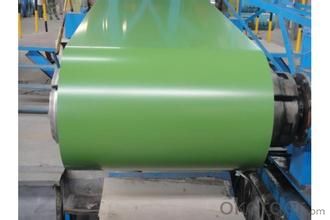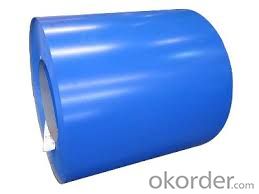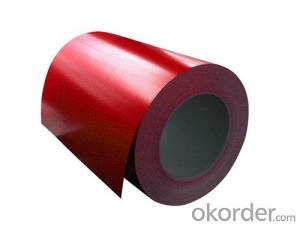Prepainted Galvanized Rolled Steel Coil -Red in China
- Loading Port:
- Tianjin
- Payment Terms:
- TT OR LC
- Min Order Qty:
- 100 m.t.
- Supply Capability:
- 500000 m.t./month
OKorder Service Pledge
OKorder Financial Service
You Might Also Like
Description Of Prepainted Galvanized Steel:
Prepainted Galvanized Steel usually refers to have substrateprocessed with surface processed and coated then(roller coated )or bonded organic thin film and baked, and it is able to be processed tofinal prodevtion .
PrepaintedGalvanized Steel qualified with excellent decorative ,formability ,corrosionresistance ,coating adhesion ,can keep for a long time as well as maintainfresh color .For color coated steel sheet can obtain good economicbenefit by steel belt wood ,efficient in construction and save energy ,preventpollution etc.Which is an ideal material;for manufacturing board.
Specifications Of Prepainted Galvanized Steel:
Thickness 0.20-1.2mm (BMT) Width 600-1250mm |
Zinc Coating 100-275g/m2 |
Color According to RAL color fan or as per request |
Internal Diameter 508mm or 610mm |
Coil Weight 3-6MT |
Quality Commercial and structural quality |
Paint Polyester paint for topside, epoxy for reverse |
Standard JIS G 3312, ASTM A755M, EN 10169 |
Base Steel Grade SGCC,SGCD,DX51D+Z,DX52D+Z;S200GD,S220GD,S280GD,S350GD,CS,FS,SS |
Applications Of Prepainted Galvanized Steel:
It can be widely used in transportation, light industry, civil usage and farming. It is also the perfect building material in construction for making steel roofing,insulation panel, corrugate sheet, facade wall,shutters,T-bar and home appliance.
Packaging & Delivery Of Prepainted Galvanized Steel:
The packing of coils consists of anti-damp paper, PVC film, hardboard paper, steel box, strapped with steel strips, fitted with locks and edge protectors and guarantees the optimal condition of the delivered goods. Each coil can be additionally fitted with wooden/steel skids(eye to the side) or wooden pallets(eye to the sky).
Images of Prepainted Galvanized Steel:


- Q: How are steel coils used in the manufacturing of agricultural structures?
- Steel coils are a vital component in the manufacturing of agricultural structures due to their durability, strength, and versatility. These coils, which are typically made from high-quality steel, are used in various ways throughout the process of constructing agricultural structures such as barns, silos, and storage buildings. One of the primary uses of steel coils in agricultural structures is in the fabrication of the building's framework. The coils are unwound and cut into specific lengths, which are then bent, shaped, and welded together to form the structural framework of the building. The strength and rigidity of steel coils make them an ideal choice for withstanding the heavy loads and harsh environmental conditions commonly found in agricultural settings. Additionally, steel coils are also used to manufacture various components and accessories for agricultural structures. These coils can be transformed into panels, roofing sheets, doors, and windows, which are essential elements in the construction of agricultural buildings. The ability to customize the shape, size, and thickness of the steel coils allows for flexibility in design and ensures that the finished structure meets the specific requirements of the agricultural application. Furthermore, steel coils play a crucial role in providing protection and safety within agricultural structures. They are used to fabricate fencing and gates, providing a secure boundary around the premises and preventing unauthorized access. Steel coils can also be used to reinforce the walls and floors of the building, enhancing its overall stability and durability. Moreover, steel coils offer excellent resistance to corrosion, which is particularly important in agricultural structures due to the exposure to moisture, chemicals, and other corrosive elements. Their durability ensures that the structure remains intact and functional for an extended period, reducing maintenance and replacement costs. In conclusion, steel coils are an essential component in the manufacturing of agricultural structures. Their strength, durability, versatility, and resistance to corrosion make them an ideal choice for constructing the framework, components, and accessories of these buildings. By utilizing steel coils in the manufacturing process, agricultural structures can be built to withstand heavy loads, harsh environmental conditions, and provide long-lasting protection for agricultural operations.
- Q: What are the different types of steel coil packaging?
- There are several types of steel coil packaging, including steel strapping, stretch wrapping, shrink wrapping, and wooden crates.
- Q: How are steel coils used in the production of storage containers?
- In the production of storage containers, steel coils play a vital role. These coils, manufactured from high-quality steel, are crucial for constructing the walls, floors, and roofs of the containers. To begin the process, the steel coil is uncoiled and passed through a series of machines that cut and shape it into the desired dimensions. Then, the steel is transformed into panels, which are either welded or riveted together to form the container's structure. The strength, durability, and resistance to corrosion make steel coils an excellent material for storage containers. They provide a robust framework that can endure heavy loads and harsh environmental conditions. Moreover, the coils can be easily molded and customized to meet specific size and shape requirements. Once the structure of the container is complete, it is typically coated with a protective layer of paint or other coatings to further enhance its durability and resistance against weather elements. This ensures that the container remains unaffected by moisture, UV rays, and other external factors that could cause deterioration. All in all, steel coils are of utmost importance in the production of storage containers as they offer the necessary strength and durability required to safely store and transport a wide array of goods and materials.
- Q: How are steel coils unloaded from a truck?
- Steel coils are typically unloaded from a truck using specific equipment and a well-coordinated process. The unloading process involves several steps to ensure the safe and efficient removal of the steel coils. Firstly, a forklift or crane is typically used to reach inside the truck bed and secure the steel coil. The forklift or crane operator carefully positions the lifting apparatus underneath the coil, ensuring that it is centered and balanced. Once the steel coil is properly secured, the forklift or crane slowly lifts it out of the truck bed while maintaining stability. The operator must be cautious and consider factors such as the weight and dimensions of the coil to prevent any accidents or damage. After the steel coil is lifted out of the truck, it is usually placed onto a designated area such as a flatbed trailer, storage rack, or directly onto the ground. If placed on the ground, protective measures such as wooden blocks or rubber mats are often used to prevent any damage to the coil or the surface it is placed on. In some cases, steel coils may be unloaded using a specialized coil trailer, which is equipped with hydraulic systems to tilt the trailer bed and roll the coil off. This method is particularly useful for unloading larger and heavier coils. Overall, unloading steel coils from a truck requires skilled operators, appropriate lifting equipment, and adherence to safety protocols. It is essential to follow these steps meticulously to ensure the safe and efficient unloading of steel coils.
- Q: Steel resist tension. Then why we provide steel in compression zone ?
- There are several reasons to add compression steel. Keep in mind, supported steel (meaning it can't buckle) resists compression as well. Compression steel helps reduce long term deflections. Concrete creeps under sustained loads. Steel lessens the compression, meaning less sustained compressive stress to cause creep deflection. It makes members more ductile. Since the steel takes some of the compressive stress, the compression block depth is reduced, increasing the strain in the tension steel at failure, resulting in more ductile behavior (the moment at first yield remains largely the same with compression steel added, but the increase in capacity after yield is significant). Compression steel insures that the tension steel yields before the concrete crushes, meaning it helps change the failure mode to tension controlled. It makes beams easier to construct. With bars in the top and bottom, you have longitudinal reinforcement in all 4 corners of the shear stirrups to keep them in place when pouring the concrete. Also, for continuous members, its often easier to run your negative moment steel the full length of the beam rather than trying to cut it off in the positive moment regions. Serviceability concerns. You're going to end up putting steel in that region anyway to for temperature and shrinkage.
- Q: I have samurai sword that is a replica of the kill bill sword. It says on the blade stainless steel, what can i use to shine and protect blade. It had and still does a wax.like coating on the blade sine i received it. Thx for ur help
- Normally okorder
- Q: Is it possible that stainless steel watches get rust. Any experience? Thanks.
- Stainless steel doesn't usually rust..... However, a lot of so-called stainless steel watch cases are actually base-metal, and does.
- Q: I'm looking for steel to make knives, but don't know what to get.
- If you are serious about making knives, I'd highly recommend visiting one of the many knifemaking forums. As usual they have good FAQs and could be good source of info, equipment and materials, let alone advices from fellow makers.
- Q: How are steel coils used in the production of elevator components?
- Steel coils play a crucial role in elevator component manufacturing. Crafted from high-quality steel specifically designed to meet the demanding requirements of elevator production, these coils are indispensable. Elevator doors heavily rely on steel coils. These coils undergo processing into flat sheets, which are then cut into desired dimensions for door creation. The doors must possess strength and durability to endure frequent use and ensure passenger safety. Steel coils provide the necessary structural integrity and resistance to deformation, essential characteristics for elevator doors. Furthermore, steel coils find application in the manufacturing of elevator cabins. After processing, the coils are molded into various shapes to construct cabin walls and flooring. Steel's strength and rigidity make it an ideal material for this purpose, enabling it to handle heavy loads and establish a secure and stable environment for passengers. Additionally, steel coils find utility in the production of elevator shafts. Rolled into cylindrical forms and welded together, these coils serve as the structural framework for the shafts. The shafts demand strength and rigidity to support the elevator's weight and ensure smooth and safe vertical movement. Steel coils fulfill these requirements by providing the necessary strength, stability, and load-bearing capacity for this critical elevator system component. To summarize, steel coils play a vital role in the production of elevator components, including doors, cabins, and shafts. Their strength, durability, and versatility make them suitable for creating reliable and secure elevator systems that efficiently transport passengers.
- Q: What are the different types of steel coil surface treatment methods?
- There are several different types of steel coil surface treatment methods that are commonly used in various industries. These methods are employed to enhance the appearance, durability, and performance of steel coils. Some of the common types of steel coil surface treatment methods include: 1. Hot-dip galvanizing: This process involves immersing the steel coil in a bath of molten zinc. The zinc coating provides excellent corrosion resistance and protects the steel from rusting. 2. Electro-galvanizing: In this method, a thin layer of zinc is electroplated onto the surface of the steel coil. It offers similar corrosion protection as hot-dip galvanizing but with a thinner coating. 3. Cold-rolled steel coil: This process involves passing the steel coil through a series of rollers at room temperature. It results in a smooth and polished surface finish, which is ideal for applications that require a high-quality appearance. 4. Pre-painted steel coil: Also known as color-coated steel coil, this treatment method involves applying a layer of paint or coating onto the steel surface. It provides an attractive appearance and additional protection against corrosion. 5. Phosphating: This treatment method involves applying a phosphate coating onto the steel surface. Phosphating improves the adhesion of subsequent coatings, such as paint or powder coating, and provides corrosion resistance. 6. Chromate conversion coating: This method involves applying a conversion coating, typically using chromium compounds, onto the steel coil surface. It enhances the paint adhesion and provides corrosion resistance. 7. Passivation: Passivation is a chemical treatment that is used to remove iron oxide and other contaminants from the steel surface. It improves the corrosion resistance of the steel coil. 8. Oiling: Oiling is a common surface treatment method that involves applying a thin layer of oil onto the steel coil surface. It helps to prevent corrosion during storage and transportation. These are some of the commonly used steel coil surface treatment methods. The choice of treatment method depends on the specific requirements of the application, such as corrosion resistance, appearance, and performance.
Send your message to us
Prepainted Galvanized Rolled Steel Coil -Red in China
- Loading Port:
- Tianjin
- Payment Terms:
- TT OR LC
- Min Order Qty:
- 100 m.t.
- Supply Capability:
- 500000 m.t./month
OKorder Service Pledge
OKorder Financial Service
Similar products
Hot products
Hot Searches
Related keywords
































